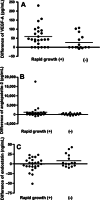Serial serum VEGF-A, angiopoietin-2, and endostatin measurements in cirrhotic patients with hepatocellular carcinoma treated by transcatheter arterial chemoembolization
- PMID: 21802642
- PMCID: PMC11916725
- DOI: 10.1016/j.kjms.2011.03.008
Serial serum VEGF-A, angiopoietin-2, and endostatin measurements in cirrhotic patients with hepatocellular carcinoma treated by transcatheter arterial chemoembolization
Abstract
Vascular endothelial growth factor (VEGF), angiopoietin-2, and endostatin have been reported to be related with angiogenesis of hepatocellular carcinoma (HCC). The potential feasibility of serial serum VEGF-A, angiopoietin-2, and endostatin measurements in cirrhotic patients with HCC treated by transcatheter arterial chemoembolization (TACE) was investigated. VEGF-A, angiopoietin-2, and endostatin serum level were determined by enzyme-linked immunosorbent assay 1 day before and 7 days after TACE in 40 patients. Then they were followed up for 3 months. The results showed that TACE could cause significant increase of VEGF-A (p < 0.01) and angiopoietin-2 (p = 0.01); whereas there was no significant change of endostatin (p > 0.1). Twenty-five patients with rapid growth of HCC within 3 months after TACE had higher proportion of American Joint Committee on Cancer HCC staging >II and higher increase of VEGF-A after TACE than 15 patients without rapid growth (all p < 0.05). Stepwise logistic regression analysis revealed that VEGF-A >16.7 pg/mL 7 days after TACE selected by receiver operating characteristic curve analysis (p < 0.05) was the only independent predictor for rapid growth of HCC (odds ratio 6.33, 95% confidence interval: upper 26, lower 1.54, p < 0.05; sensitivity 76%, specificity 66.7%, accuracy 72.5%, positive predictive level 79.2%, negative predictive level 62.5%, p < 0.01). In conclusion, significant increases of serum level VEGF-A and angiopoietin-2 after TACE have been demonstrated from this study. Therefore, serial VEGF-A level 1 day before and 7 days after TACE may be used to predict rapid HCC growth.
Copyright © 2011. Published by Elsevier B.V.
Figures


Similar articles
-
Association between increment of serum VEGF level and prognosis after transcatheter arterial chemoembolization in hepatocellular carcinoma patients.Cancer Sci. 2008 Oct;99(10):2037-44. doi: 10.1111/j.1349-7006.2008.00909.x. Cancer Sci. 2008. PMID: 19016764 Free PMC article.
-
Vascular endothelial growth factor and tryptase changes after chemoembolization in hepatocarcinoma patients.World J Gastroenterol. 2015 May 21;21(19):6018-25. doi: 10.3748/wjg.v21.i19.6018. World J Gastroenterol. 2015. PMID: 26019468 Free PMC article.
-
Transcatheter arterial chemoembolization (TACE) in hepatocellular carcinoma (HCC): the role of angiogenesis and invasiveness.Am J Gastroenterol. 2008 Apr;103(4):914-21. doi: 10.1111/j.1572-0241.2007.01712.x. Epub 2008 Jan 2. Am J Gastroenterol. 2008. PMID: 18177453
-
Prognostic value of serum HIF-1α change following transarterial chemoembolization in hepatocellular carcinoma.Clin Exp Med. 2021 Feb;21(1):109-120. doi: 10.1007/s10238-020-00667-8. Epub 2020 Oct 9. Clin Exp Med. 2021. PMID: 33037574
-
Efficacy of endostar combined with transcatheter arterial chemoembolization and analysis of vascular endothelial factor and C-reactive protein levels in patients with advanced hepatocellular carcinoma under contrast enhanced ultrasound.J BUON. 2019 Nov-Dec;24(6):2394-2401. J BUON. 2019. PMID: 31983111
Cited by
-
γ-H2AX promotes hepatocellular carcinoma angiogenesis via EGFR/HIF-1α/VEGF pathways under hypoxic condition.Oncotarget. 2015 Feb 10;6(4):2180-92. doi: 10.18632/oncotarget.2942. Oncotarget. 2015. PMID: 25537504 Free PMC article.
-
The Angiopoietin/Tie2 Pathway in Hepatocellular Carcinoma.Cells. 2020 Oct 30;9(11):2382. doi: 10.3390/cells9112382. Cells. 2020. PMID: 33143149 Free PMC article. Review.
-
Tumor Biomarkers and Interventional Oncology: Impact on Local Outcomes for Liver and Lung Malignancy.Curr Oncol Rep. 2021 Apr 15;23(6):67. doi: 10.1007/s11912-021-01056-4. Curr Oncol Rep. 2021. PMID: 33855606 Review.
-
Comparative Effectiveness and Safety of Molecular Targeted Therapy Plus PD-(L)1 with or without TACE in Unresectable Hepatocellular Carcinoma: A Retrospective Study.Immunotargets Ther. 2025 Jul 17;14:761-771. doi: 10.2147/ITT.S495451. eCollection 2025. Immunotargets Ther. 2025. PMID: 40693263 Free PMC article.
-
Expression of cluster of differentiation 151 prior to and following transcatheter arterial chemoembolization therapy in patients with hepatocellular carcinoma and its association with clinicopathological characteristics.Oncol Lett. 2018 Jan;15(1):1133-1142. doi: 10.3892/ol.2017.7371. Epub 2017 Nov 8. Oncol Lett. 2018. PMID: 29391901 Free PMC article.
References
-
- Sugimachi K., Tanaka S., Terashi T., Taguchi K., Rikimaru T., Sugimachi K.. The mechanisms of angiogenesis in hepatocellular carcinoma: angiogenic switch during tumor progression. Surgery. 2002; 131: S135–S141. - PubMed
-
- Shinkaruk S., Bayle M., Laïn G., Déléris G.. Vascular endothelial cell growth factor (VEGF), an emerging target for cancer chemotherapy. Curr Med Chem Anticancer Agents. 2003; 3: 95–117. - PubMed
-
- Shibuya M.. Vascular endothelial growth factor‐dependent and ‐independent regulation of angiogenesis. BMB Rep. 2008; 41: 278–286. - PubMed
-
- Mise M., Arii S., Higashituji H., Furutani M., Niwano M., Harada T., et al. Clinical significance of vascular endothelial growth factor and basic fibroblast growth factor gene expression in liver tumor. Hepatology. 1996; 23: 455–464. - PubMed
-
- Suzuki K., Hayashi N., Miyamoto Y., Yamamoto M., Ohkawa K., Ito Y., et al. Expression of vascular permeability factor/vascular endothelial growth factor in human hepatocellular carcinoma. Cancer Res. 1996; 56: 3004–3009. - PubMed
Publication types
MeSH terms
Substances
LinkOut - more resources
Full Text Sources
Medical
Miscellaneous

